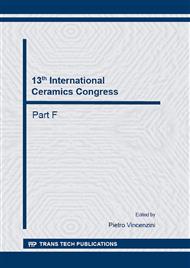[1]
Davidovits, J., Geopolymer Chemistry and Applications. 2011, Saint-Quentin, France: Institut Géopolymère.
Google Scholar
[2]
Kuenzel, C., et al., Ambient Temperature Drying Shrinkage and Cracking in Metakaolin-Based Geopolymers. Journal of American Ceramic Society, 2012. 95(10): p.3270–3277.
DOI: 10.1111/j.1551-2916.2012.05380.x
Google Scholar
[3]
Lemougna, P.N., et al., The role of iron in the formation of inorganic polymers (geopolymers) from volcanic ash: a 57Fe Mössbauer spectroscopy study. Journal of Materials Science, 2013. 48(15): pp.5280-5286.
DOI: 10.1007/s10853-013-7319-4
Google Scholar
[4]
Lecomte, I., et al., (Micro)-structural comparison between geopolymers, alkali-activated slag cement and Portland cement. Journal of the European Ceramic Society, 2006. 26(16): pp.3789-3797.
DOI: 10.1016/j.jeurceramsoc.2005.12.021
Google Scholar
[5]
Machiels, L., et al., Inorganic polymer cement from Fe-silicate glasses: varying the activating solution to glass ratio. Waste and Biomass Valorization, (2014).
DOI: 10.1007/s12649-014-9296-5
Google Scholar
[6]
Onisei, S., et al., Synthesis of inorganic polymers using fly ash and primary lead slag. Journal of Hazardous Materials, 2012. 205-206(0): pp.101-110.
DOI: 10.1016/j.jhazmat.2011.12.039
Google Scholar
[7]
Davidovits, J., et al., Geopolymer cement of the calcium ferro-aluminosilicate polymer type and production process. 2013. AU2011322378(AU2011322378 20111026 ).
Google Scholar
[8]
van Deventer, J., et al., Chemical Research and Climate Change as Drivers in the Commercial Adoption of Alkali Activated Materials. Waste and Biomass Valorization, 2010. 1(1): pp.145-155.
DOI: 10.1007/s12649-010-9015-9
Google Scholar
[9]
Kalinkin, A.M., et al., Geopolymerization behavior of Cu-Ni slag mechanically activated in air and in CO2 atmosphere. International Journal of Mineral Processing, 2012. 112-113: pp.101-106.
DOI: 10.1016/j.minpro.2012.05.001
Google Scholar
[10]
Jones, P.T., et al., Enhanced Landfill Mining in view of multiple resource recovery: a critical review. Journal of Cleaner Production, 2013. 55: pp.45-55.
DOI: 10.1016/j.jclepro.2012.05.021
Google Scholar
[11]
Rietveld, H.M., A method for including the line profiles of neutron powder diffraction peaks in the determination of crystal structures. Acta Crystallographica, 1966. 21: p. A228.
Google Scholar
[12]
Rietveld, H.M., A profile refinement method for nuclear and magnetic structures. Journal of Applied Crystallography, 1969. 2: pp.65-71.
Google Scholar
[13]
Zhang, Z., et al., Using fly ash to partially substitute metakaolin in geopolymer synthesis. Applied Clay Science, 2014. 88-89(0): pp.194-201.
DOI: 10.1016/j.clay.2013.12.025
Google Scholar
[14]
Bernal, S.A., et al., Evolution of binder structure in sodium silicate-activated slag-metakaolin blends. Cement and Concrete Composites, 2011. 33(1): pp.46-54.
DOI: 10.1016/j.cemconcomp.2010.09.004
Google Scholar
[15]
Bell, J.L. and W.M. Kriven, Preparation of ceramic foams from metakaolin-based geopolymer gels Ceramic Engineering and Science Proceedings, 2010. 29(10): pp.97-112.
DOI: 10.1002/9780470456200.ch10
Google Scholar
[16]
Lizcano, M., et al., Effects of water content and chemical composition on the structural properties of alkaline activated metakaolin-based geopolymers. Journal of American Ceramic Society, 2012. 95(7): pp.2169-2177.
DOI: 10.1111/j.1551-2916.2012.05184.x
Google Scholar
[17]
Morgan, G.B. and D. London, Optimizing the electron microprobe analysis of hydrous alkali aluminosilicate glasses. American Mineralogist, 1996. 81: pp.1176-1185.
DOI: 10.2138/am-1996-9-1016
Google Scholar
[18]
Morgan, G.B. and D. London, Effect of current density on the electron microprobe analysis of alkali aluminosilicate glasses. American Mineralogist, 2005. 90: pp.1131-1138.
DOI: 10.2138/am.2005.1769
Google Scholar


